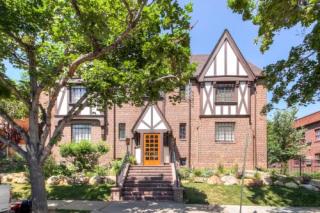The City Park neighborhood was included in the city by Territorial Sessions Laws of 1874 and the Colorado Sessions Laws of 1889. From 1882 to 1920, three subdivisions were recorded. Three major developments — City Park, East High School and Mercy Hospital are particularly significant to the area’s history.
In 1890, Henry Lee sponsored a bill in the State Legislature authorizing municipalities to acquire lands in excess of the then current 40 acre limit for parks. He had in mind not only the 320 acres proposed for City Park, but also Sloan’s Lake and surrounding state-owned land. After the bill passed and years of litigation over land ownership had been settled, Denver purchased the City Park site for $56,000 in 1889. At that time there were few trees and the vegetation consisted of buffalo grass, sage brush and cactus.
After acquisition, the park board set about the task of seeding part of the area in grass, and a former Denver mayor, Richard Sopris, became the first park superintendent. School children helped in the task of beautifying the area by making the planting of fast-growing cottonwood trees their Arbor Day project.
But trees, flowers and lawn were not enough for Denver residents. A bandstand was constructed to accommodate concerts, a race track was built and quite by accident, the zoo was established when a city employee donated his pet bear cub which persisted in breaking its chain and killing his chickens. The bear became such an attraction that other Colorado animals were added, and later by popular demand, species from all over the world were included. Later, a group of citizens purchased an exhibit of bison and other fauna of the mountains and established the Colorado Museum of Natural History. Today, the museum contains one of the finest collections of native animals and birds, exhibited in their natural habitats, in the country. With the addition of an electric fountain in 1908 and numerous donated statues and gateways, the park became a focal point of Denver.
Today, City Park contains playground equipment for children, a miniature railroad, two lakes, handball and tennis courts, horseshoe pits, a zoo and the Museum of Natural History. It remains a major attraction to both city residents and visitors alike.
The second development of significance to the neighborhood’s history occurred in 1925, with the construction of the new’ East Denver High School at 1545 Detroit Street. A 20-acre site adjacent to the City Park Esplanade and East 16th Avenue was chosen to repeat the architectural triumph of the old East High, (presently the site of the New Custom House). The magnificent structure was built to accommodate 2,130 students, and was furnished with the latest in modern high school equipment.
The school’s central clock tower is 162 feet high and is situated to be visible along the length of East 16th Avenue. Denver Public Schools built an addition onto East in 1975, to make space for the for the lunchroom and science classes. In 1882, five Sisters of Mercy volunteered to leave St. Joseph ‘s Convent of the Sisters of Mercy in St. Louis, Missouri, to practice their vocation in the new state of Colorado. They were led by Sister (later Mother) Mary Baptist Meyers on a mission to establish hospitals, schools and convents in Durango, Ouray, Cripple Creek, San Luis, Greeley and Denver.
The Sisters of Mercy founded Mercy Sanitarium in Denver in 1901 at 1619 Milwaukee Street with a 40-bed capacity. An addition was built in 1903, which provided accommodations for 85 more patients. At the same time, the facility’s name was changed to Mercy Hospital. From 1905 to 1932 the hospital underwent constant construction and remodeling which brought the facility to a capacity of 250 beds. In 1974, ground was broken for the Mercy Hospital Plaza and parking structure. In 1975, the hospital opened its Intensive Care/Coronary Care-Unit and expanded its emergency and physical therapy facilities.



